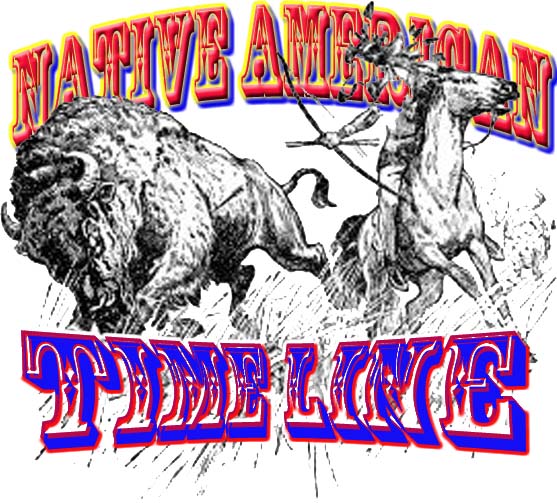1704
Former Governor of South Carolina, James Moore, led a force of 50 British, and 1,000 Creek Indians against Spanish settlements. They attacked a Mission in Northwestern Florida. They took many Indians as slaves and killed Father Manuel de Mendoza.
1709
A slave market was erected at the foot of Wall Street in New York City. Here African-Americans and Indians — men, women and children were daily declared the property of the highest cash bidder.
1711
In North Carolina, the Tuscarora War, led by Chief Hancock, was fought between the British, Dutch, and German settlers and the Tuscarora Native Americans.
In an attempt to drive the colonists out of their territory, the tribe attacked several settlements, killing settlers and destroying farms. In 1713, James Moore and Yamasee warriors defeated the Indians.
1715-18
The Yamasee War occurs in southern Carolina, which came close to exterminating white settlements in their region.
1716
South Carolina settlers and their Cherokee allies attack and defeat the Yamassee.
1725
Ten sleeping Indians were scalped by whites in New Hampshire for a bounty.
1745
Upon hearing of an impending French and Indian attack upon the Ulster county frontiers, Europeans massacred several Indian families in their wigwams at Walden in the Hudson River Valley.
French military forces out of Canada, accompanied by 220 Caughnawaga Mohawk and Abenaki Indians, attacked and burned the English settlement at Saratoga.
1756
A declaration of war on the Delaware and Shawnee Indians with “The Scalp Act” that put a bounty on the scalps of Indian men, women and boys.
1758
The first Indian reservation in North America was established by the New Jersey Colonial Assembly.
1759
Comanche raids at missions on the San Saba River triggered a battle north on the Red River between several thousand Indians against 600 Spaniards who were forced to retreat.
1760-62
Cherokee Uprising – A breakdown in relations between the British and the Cherokee leads to a general uprising in present-day Tennessee, Virginia and the Carolinas.
1762
New Mexico Indians are tired for witchcraft and condemned into servitude.
Trying to ease tension with Native Americans, King George III signed the Proclamation of 1763 stopped any settlement of land west of the Appalachian Mountains.
1763
Ottawa leader Pontiac destroys several British forts and held Detroit under siege.
Sir William Johnson the Indian Commissioner compensates settlers for losses during Indian raids.
In response to Pontiac’s attacks the Paxton Boys kill 20 peaceful Susquehannock Indians in Pennsylvania.
The last remaining surviving Conestoga Indians are hached to death at the workhouse in Lancaster, Pennsylvania.
1775
Indians in San Diego rebell against force missionaries’ teachings and labor, burn city and kill the mission’s head priest.
1776
The Continental Congress tried to recruit Indians to serve the United Colonies but the tribes refused to fight for the colonists.
1772-80
Eighty percent of the Arikara died of smallpox, measles, etc.
1776-94
Chickamauga Wars, Dragging Canoe’s Cherokee warriors fought white settlers in Tennessee, Kentucky, Virginia, North Carolina, South Carolina a, and Georgia.
1781
Smallpox wiped out more than half the Piegan Blackfoot.
1782
Gnadenhutten Ohio, 96 pacifist, Christian Delaware Native American adults and children are slaughtered by a Captain David Williamson’s volunteers.
In San Francisco the Spanish build the Presidio to protect the mail from Indians along El Camino Real.
1785-95
War in Ohio and Indiana many victories for Native Americans, “Mad Anthony” Wayne wins victory at the Battle of Fallen Timbers.
1786
Native Americans are told in the Northwest Ordinance that their property, rights and liberty will never be disturbed.
1787
First federal treaty enacted with the Delaware Indian.
1789
Congress expands its control over the native people with the addition to the Constitution of the Indian commerce Clause, and they authorized Indian agents to negotiate treaties.
1790
The federal government is given control over Native American relations between them and other peoples, and promises to protect boundaries, trade, and them from aggression.
1790
Native Americans were not listed in the first U.S. Census, African-Americans were.
1795
Trading begins between Native Americans and French and Spanish merchants from St. Louis, Missouri.
1792
George Washington complains about “Indian hostilities” north of the Ohio River in his 4th annual address to Congress.
1795
The Treaty of Greenville ended the tribal war of fought by the Shawnee that resisted settlers in Ohio, and the Indians were promised permanent borders between their land and the rest of America.
>>to return to previous page – right click on back arrow <<
Word count: 703





































